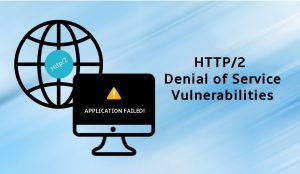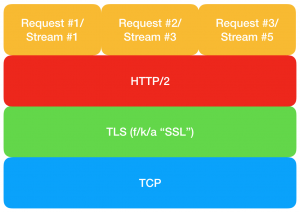What is HTTP/2 ?
HTTP/2 is an updated version of the HTTP protocol and was released in 2015. After the changes in HTTP specifications in 1999, this was the next major update that was issued for HTTP. HTTP/2 is based on SPDY protocol which is used in popular products like Google Chrome, Mozilla Firefox, Microsoft Internet Explorer, etc. HTTP/2 enables faster browsing and encryption capabilities. A Vulnerability Management System can prevent these attacks.
Jonathan Looney of Netflix and Piotr Sikora of Google discovered a set of vulnerabilities in HTTP/2 that impact the availability of servers using HTTP/2 worldwide. According to W3Techs, 40% of the websites on the internet use HTTP/2. A good Vulnerability management tool can solve these issues.
What causes these security holes in HTTP/2?
RFC7540 has outlined a few general security considerations for denial of service conditions in HTTP/2. The recently discovered vulnerabilities do not fall in the scope of the security considerations discussed by RFC7540.
HTTP/2 uses header compression, requiring a strict resource commitment compared to HTTP/1.1.The attack vectors for the vulnerabilities discovered in HTTP/2 follow a certain pattern. The main goal is to setup a queue of responses to exhaust the resources on a server. A malicious client asks the server to return responses to certain requests. Therefore, the client does not read these responses and builds up in a queue. The efficiency of queue handling in a server decides how much CPU and/or memory resources are consumed in such a situation. Excessive usage of the resources leads to a crash.
These attacks are designed to work at the HTTP/2 transport layer. This layer lacks systematic tooling to log, rate-limit, and trigger remediation corresponding to the client’s behavior at the HTTP/2 connection layer.
The HTTP/2 vulnerabilities impact only the availability of servers and do not allow an attacker to leak or modify information.
Attack Vectors in servers that support HTTP/2 communication
The following CVEs outline the various methodologies to exhaust the CPU and memory resources, thereby causing a crash or denial of service condition:
- CVE-2019-9511 (Data Dribble) : An attacker can make a request to the server to return huge amounts of data from a specified resource over multiple streams. The server must queue the data in 1-byte chunks by manipulating the window size and stream priority. At this point, there is an excessive memory and/or CPU consumption depending on the server’s efficiency to handle queues.
- CVE-2019-9512 (Ping Flood): An internal queue of responses can be built up by sending continual pings to an HTTP/2 peer. Different amounts of CPU and memory resources are utilized depending on how efficiently this data is queued. Excessive consumption leads to denial of service.
- CVE-2019-9513 (Resource Loop): An attacker creates multiple request streams and continuously shuffles the streams’ priority. This causes a substantial churn to the priority tree, leading to excessive CPU consumption and a crash.
-
CVE-2019-9514 (Reset Flood) :
An attacker sends invalid requests over multiple streams expecting to receive RST_STREAM frames from the peer. RST_STREAM frames are returned in HTTP/2 when a client aborts the request while keeping the connection open. Different amounts of CPU and memory resources are in consumption depending on the handling of RST_STREAM frames in the queue. Excessive consumption leads to denial of service.
- CVE-2019-9515 (Settings Flood): RFC specifies that the peer should reply with one acknowledgment for every SETTINGS frame. An attacker can abuse this functionality by sending a stream of SETTINGS frames to the peer. Moreover, different amounts of CPU and/or memory resources are in consumption depending on the efficiency of handling the data. Excessive consumption leads to denial of service.
- CVE-2019-9516 (0-Length Headers Leak) : Some implementations allocate a certain memory for request headers and keep them intact until the session expires. An attacker can abuse this functionality by sending a stream of headers with a 0-length header name and a 0-length header value with a size of 1 byte or greater. This can consume excess memory and lead to denial of service conditions.
-
CVE-2019-9517 (Internal Data Buffering) :
An attacker opens an HTTP/2 window and closes a TCP window. Sending a stream of requests for a large response object results in excess memory consumption and a crash. This happens because, opening an HTTP/2 window allows the peer to send without limitations but does not allow it to write bytes on the wire. This builds up a queue of responses and excess memory consumption, leading to service denial.
- CVE-2019-9518 (Empty Frames Flood) : An attacker sends a stream of frames (DATA, HEADERS, CONTINUATION and/or PUSH_PROMISE) without the flag, which indicates the end of the stream. However, The peer processes every frame disproportionate to attack bandwidth leading to excessive CPU consumption. This causes denial of service.
Cloudflare reported that some attacks are observing in the wild. Therefore it is a high recommendation to install the updates available from vendors.
Affected Products:
All servers that support HTTP/2 communication are problematic. An extensive list of vendors affecting by this vulnerability can be here. It is important to note that not all products are affecting by vulnerabilities. Moreover, The respective vendors have published information about the vulnerabilities related to their products in the advisories.
Impact:
Successful exploitation of these vulnerabilities leads to Denial of Service conditions. However, Some of them enable a single-end system to disrupt the service on multiple servers.
Solution:
Many vendors including Cloudflare, Microsoft(CVE-2019-9511, CVE-2019-9512, CVE-2019-9513, CVE-2019-9514, CVE-2019-9518), Apple(SwiftNIO), NGINX, Nodejs, Ubuntu released updates to mitigate these vulnerabilities. Apache releases an advisory stating that Tomcat is not affecting by the DoS vulnerabilities. But, the subsequent versions would be handling abusive client behavior. Updates were also releasing for Google Go . Synology has mentioned the list of products affected in an advisory, but has not released updates so far.
Workaround:
Netflix suggests that a possible workaround is to disable the HTTP/2 support. They have also warned that might cause a degradation in the performance and might not be possible in all cases.


